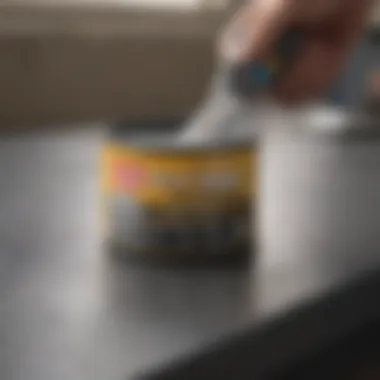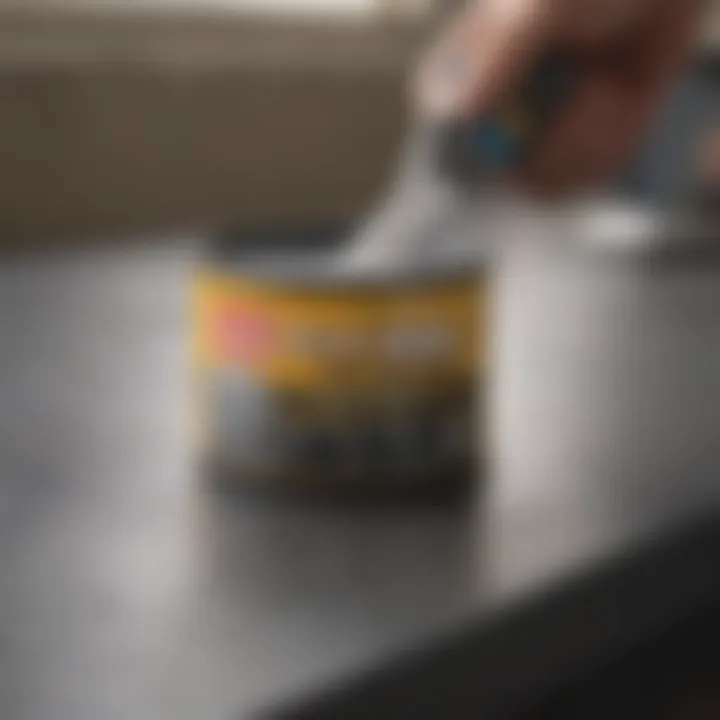Evaluating Flex Seal's Effectiveness on Plastic Materials


Intro
Flex Seal is not just a name thrown around in DIY conversations. It's a product that has slipped into the toolkit of homeowners, car enthusiasts, and even industrial workers. Its ability to manage a variety of plastic repairs elevates its importance in the home improvement industry. Whether it’s a cracked garden chair, a leaky toy, or even parts of a vehicle, this sealant has made waves by asserting that it can tackle jobs that many would deem unfixable.
Understanding the efficacy of Flex Seal when it comes to plastic applications is crucial. It allows users to save money on purchasing new items, while at the same time wielding the power of repair and enhancement in their hands. With the economy tightening and sustainability becoming ever more relevant, the allure of repairing over replacing stands out brightly.
Overview of Topic
The topic centers around the application and effectiveness of Flex Seal specially tailored for plastic materials. As we venture deeper into home improvement, many are often faced with broken plastic items – whether they be household goods, children's toys, or components of vehicles. The urgency of finding reliable solutions creates a niche where Flex Seal shines brightly.
Navigating the waters of repair can be daunting, especially when dealing with various types of plastics. Not all adhesives work uniformly on plastic, and tackling each challenge demands an understanding of the materials involved. The durability and versatility of a product like Flex Seal gives homeowners a fighting chance to overcome obstacles without breaking the bank on replacements.
Common Challenges and Solutions
While Flex Seal may offer an efficient solution, it's essential to acknowledge the common bumps on the road when homeowners attempt plastic repairs.
- Identifying the Right Type of Plastic: Various plastics, such as PVC or polyethylene, can react differently to sealants.
- Surface Preparation: Many folks rush the preparation phase, leading to less effective bonding.
- Application Techniques: Ensuring even application is pivotal for effective results.
- Solution: Understand the specific type of plastic you're dealing with before applying any product. A quick test or internet research can spare you the headache.
- Solution: Clean the surface diligently from dust, grease, or residues. Utilizing fine-grit sandpaper can enhance adhesion.
- Solution: Use steady hands. Practice makes perfect, and you might find if you’re using spray or liquid for the first time, try a few practice swipes on scrap material.
"Preparation is key; without it, even the best products may falter in their effectiveness."
Product Recommendations
When scoping out Flex Seal for plastic applications, a few standout products deserve a closer look. Their unique formulations cater directly to those tackling plastic issues:
- Flex Seal Spray: Known for its versatility, it can reach tricky areas easily and creates a waterproof barrier.
- Flex Glue: This powerful adhesive bonds to a wide range of materials and boasts significant strength for plastic repairs.
- Flex Tape: While touted for its use on pipes, it can also serve well on plastic items needing patchwork.
All these options carry their own benefits, so evaluating them based on your specific needs will play a pivotal role.
Step-by-Step Guides
- Assess the Damage: Begin with a detailed inspection of the item needing repair. Identify cracks or breaks clearly.
- Choose the Right Product: Based on the damage and plastic type, select the most suitable Flex Seal product.
- Prepare the Surface: Clean and sand down the plastic surface thoroughly to achieve a strong bond.
- Application: Follow the instructions on the product carefully. Apply evenly, ensuring complete coverage over cracks or joins.
- Allow to Cure: Patience plays a key role. Let the repair cure properly as per the product instructions before using the item again.
- Test the Repair: After curing, gently test the repaired item. Ensure it holds up under light use before diving back into normal operations.
Delving into the world of Flex Seal for plastic applications reveals a plethora of possibilities. From addressing common homeowner issues to directing actions step by step, it becomes clear that the right tools in hand enable creativity and problem-solving. So the next time you find a dent in your garden chair or a crack in a toy, remember that Flex Seal could be just what you need to restore functionality.
Prelims to Flex Seal
In an age where quick fixes often need to withstand the test of time, understanding the role of Flex Seal has become essential for anyone dealing with plastic. This flexible sealant isn't just another home improvement product; it's a game changer for various applications in households, automotive settings, and even in industrial contexts. House owners and DIY enthusiasts alike find themselves drawn to its promises of durability, convenience, and effectiveness. This section sets the stage for exploring Flex Seal’s unique qualities and diverse uses.
Overview of Flex Seal Products
Flex Seal offers a range of products that cater to different needs, particularly when it comes to plastic. The flagship product, Flex Seal Liquid, is designed to be poured, brushed, or rolled on surfaces, providing an extremely waterproof coating. In contrast, Flex Seal Spray allows for a more targeted application, ideal for reaching those tricky spots or tight corners.
- Liquid Formula: Great for large areas and provides a thicker coating.
- Spray Formula: Fits well for detailed projects or smaller touch-ups.
- Flex Tape: A robust, rubberized tape that seals out water and air; perfect for immediate repairs.
Understanding these offerings helps homeowners select the right product based on their specific needs, whether it’s stopping leaks or enhancing plastic durability.
Understanding the Sealant Composition
At its core, Flex Seal is all about its composition, which consists of a special blend of rubberized material. This unique foundation allows it to create a strong bond with various plastics, enhancing its overall utility. The key components include:
- Natural Rubber: This provides excellent adhesion and flexibility, making it suitable for different temperatures.
- Chemical Fillers: These help improve the performance by adding strength and resistance.
- Solvents: Used to maintain the correct viscosity for easy application.
With this careful blend, Flex Seal can expand and contract with the underlying material without losing its grip. It’s this attribute that sets it apart from traditional adhesives, as it can adapt to the sometimes problematic behavior of plastics that expand in heat or contract in cold. Understanding these ingredients not only demystifies the product but also empowers users make informed decisions for their home projects.
"Flex Seal is not just a band-aid; it's a reliable solution for your plastic repair needs."
By knowing the products and their compositions, readers can approach their next project with greater confidence, ready to tackle anything from repairing broken garden furniture to sealing cracks in a plastic storage container.
Analyzing Plastic Materials
When we talk about using Flex Seal on plastics, it's vital to take a step back and really get to grips with the materials involved. Understanding the types of plastics available and their unique properties can make a significant difference in how effective the sealant is. Not every type of plastic is created equal; they come with their own quirks, strengths, and weaknesses. By honing in on the nature of plastic materials, users can make informed decisions on which applications to pursue, ensuring optimal results with Flex Seal.
Types of Plastic Commonly Used


Plastics are everywhere, and they come in various forms, each suited to particular tasks. While there are many types, here are a few prevalent ones that homeowners might encounter:
- Polyethylene (PE): This is perhaps the most common plastic. It's lightweight, resistant to moisture, and often used in grocery bags. However, its surface can be tricky for adhesives to grip well.
- Polyvinyl Chloride (PVC): Known for its durability, PVC is frequently seen in plumbing. It's rigid and resistant to a range of chemicals but may need surface preparation for better adhesion.
- Acrylic (PMMA): Clear, glossy, and tough, acrylic is often used in applications where visibility matters, like display cases. It's fairly easy to bond, though impacts can crack it.
- Polycarbonate (PC): Known for its strength, polycarbonate is often used in safety goggles and eyewear. While it's a tough cookie, the surface requires careful treatment to ensure a solid seal.
- ABS (Acrylonitrile Butadiene Styrene): This material combines toughness with flexibility and is often found in toys or automotive components. It's fairly resistant to heat and impacts, making it a popular choice.
By being aware of these common types and where they’re typically used, homeowners can tailor their approach, employing Flex Seal with precision rather than as a one-size-fits-all solution.
Properties of Different Plastics
Each type of plastic brings unique attributes to the table, which can influence how well Flex Seal works once applied. Here’s a brief look into some of those properties:
- Strength: Some plastics, like polycarbonate, are incredibly strong but can be hard to bond without proper surface prep. Their excellent toughness means they can take a beating, but if the adhesive fails, the whole purpose can go out the window.
- Flexibility: While materials such as ABS provide some flexibility, rigid plastics like PVC may become brittle over time. Understanding flexibility helps in knowing the potential for stress fractures down the line.
- Surface Texture: Smooth surfaces, typical of polyethylene, may hinder adhesion. Textured plastics, on the other hand, could offer better grip for Flex Seal. A light sanding of smooth plastics can enhance adhesion.
- Chemical Resistance: Many plastics are resistant to various chemicals, including water and oil. However, knowing the specific resistance of each plastic type can guide the application of Flex Seal, preventing future peeling or failure.
Understanding the specific properties of different plastics is the key to achieving a successful bond with Flex Seal.
Rather than eyeing up Flex Seal as a miracle solution, it’s crucial to be mindful of the underlying material. By analyzing the characteristics of the plastic at hand, homeowners can enhance the performance of Flex Seal, ensuring repairs or enhancements stand the test of time and use.
The Science Behind Adhesion
Understanding how Flex Seal adheres to plastic is fundamental in determining its efficacy and performance. Adhesion refers to the ability of two substances to stick together. In the case of Flex Seal, its adhesive properties play a critical role in its application across various surfaces, particularly plastics. Plastic materials often come with unique challenges. Different types of plastic have different chemical compositions, surface textures, and porosities, which can affect how any sealant sticks.
For homeowners and DIY enthusiasts, knowing the science behind this adhesion can make the difference between a successful repair and a failed one. When properly applied, Flex Seal acts like a second skin for plastic surfaces, forming a barrier that resists moisture, air, and other potential contaminants.
How Flex Seal Bonds to Plastic
Flex Seal employs a unique combination of solvents and rubber to create its adhesion mechanism. Upon application, it disperses into the microscopic grooves of the plastic surface. As it cures, the solvents evaporate, leading to a robust bond as the rubber forms a continuous layer over the plastic. This rubberized coating is not just for show; it provides flexibility and strong grip, making the bond resilient even under changing environmental conditions.
Moreover, for optimal adhesion, the application surface should be clean, dry, and free of contaminates. Notably, surfaces that are rough or textured can enhance adhesion, as they provide more area for the sealant to grip. On the flip side, greasy or oily surfaces will lead to poor adhesion, causing the seal to fail prematurely.
Factors Affecting Adhesion Strength
Adhesion strength is influenced by several factors. When using Flex Seal on plastic, consider the following important elements:
- Surface Preparation: Cleaning the plastic thoroughly ensures better adhesion. Remove any dust, grease, or old paint.
- Temperature and Humidity: Extreme temperatures can adversely affect the performance of Flex Seal. It’s best to apply it in mild conditions.
- Plastic Type: Different plastics, such as polyethylene or polystyrene, will react differently. Some may require priming before application to enhance bonding.
- Thickness of Coating: A thicker application usually results in stronger adhesion, but it must be balanced with the potential for runs or drips.
"A solid bond comes from both preparation and the right conditions. Neglecting any part of the process can lead to premature failure of the bond."
While Flex Seal is versatile, being aware of these factors can help ensure a successful application every time. With that consideration, homeowners can approach their plastic repair tasks with confidence, clearly understanding how to optimize the use of Flex Seal.
Practical Applications of Flex Seal
Flex Seal is more than just a product; it's a game changer for those working with plastic. Its ability to not only seal but also enhance plastic applications makes it an essential tool in many households and industries. Understanding where and how to apply this versatile sealant amplifies its effectiveness and offers a practical solution to various challenges. Here, we will explore three key areas where Flex Seal shines—household use cases, automotive repairs, and industrial applications.
Household Use Cases
When it comes to household fixes, Flex Seal proves invaluable. Whether it’s a pesky leak in a garden hose or a crack in a plastic storage container, this sealant can temporarily or permanently restore functionality. One distinct advantage is its easy application, which means even those not inclined toward DIY can handle it without a hitch.
In the kitchen, for example, you might face a broken plastic dish that you don't want to part with. Just spray on some Flex Seal, and it’ll form a protective layer, allowing you to keep using it without concern for leaks or breaks.
Benefits of household use:
- Quick Fix: Provides an instant solution that can save time and money.
- Waterproof: Ideal for areas that require moisture resistance, like gutters or downspouts.
- Flexible Finish: Adapts to the movements of plastic materials without cracking over time.
While applying it in the kitchen, just ensure that the area is well-ventilated. Although it's generally safe, good air circulation can eliminate any strong odors during application.
Automotive Repairs and Enhancements
Flex Seal also finds its way into the automotive sector, where its functionality knows no bounds. Plastic parts in vehicles, whether inside or outside, can be susceptible to wear and tear. Using Flex Seal effectively extends their life, resulting in cost savings over time.
Take, for example, a crack in your car’s bumper. Many might think replacing the entire part is necessary, but a little Flex Seal can do wonders. Spraying it onto the crack not only seals it but also offers an added layer of protection against the elements.
- Application Advantages:
- Temperature Resistant: Works well in both high and low temperatures, protecting against environmental stresses.
- Paintable Surface: Once dried, it can be painted over to match the car's color and maintain aesthetics.
- UV Protection: Prevents plastic parts from degrading due to sun exposure.
Flex Seal for automotive use is particularly effective for minor repairs and enhancements, allowing drivers to maintain their vehicles effectively without breaking the bank.
Industrial and Commercial Applications
In industrial settings, the demand for reliable sealants is crucial. Flex Seal has carved out a niche for itself in various commercial applications. Whether used on pipelines, tanks, or machinery, its efficacy ensures operational reliability.


Consider the scenario of a leaking plastic tank in a manufacturing facility. Instead of shutdown and costly repairs, a well-applied layer of Flex Seal can provide a quick-tack solution that can hold up under pressure, both physically and chemically.
Key Points for Industrial Use:
- Durability: Stands up against harsh chemicals and solvents found in many industries.
- Reduced Downtime: Quick fix solutions mean less time lost to repairs, enhancing overall efficiency.
- Versatile Material Compatibility: Works on various types of plastic, making it an adaptable choice for different contexts.
Flex Seal proves that not all heroes wear capes; in fact, some come in spray cans.
Advantages of Using Flex Seal on Plastic
When it comes to tackling tasks around the home, we’re always on the lookout for solutions that make our lives easier. Flex Seal, a rubberized sealant, offers several advantages when applied to plastic surfaces. It’s essential to understand these benefits not just for practical reasons, but also to make informed decisions about repairs or enhancements.
One of the standout features of Flex Seal is its waterproofing capabilities. Plastic, while sturdy, can still be prone to leaks and moisture infiltration, especially in areas like gardens or near plumbing. Flex Seal forms a thick barrier that wards off water, ensuring that materials beneath it remain dry. This waterproof nature is invaluable for homeowners looking to prolong the life of their plastic fixtures.
Additionally, Flex Seal is known for its versatility across various surfaces. Many materials can be finicky when it comes to adhesion; however, Flex Seal provides a reliable bond not just to plastic, but to other surfaces as well. Whether you’re working with PVC pipes, plastic garden planters, or even DIY art projects, this sealant adapts to different textures while maintaining its integrity over time.
Lastly, one can’t overlook its curing time and handling. Unlike some complex adhesives that require careful measuring and wrestling with complicated application processes, Flex Seal simplifies these tasks. It usually cures quickly, allowing for minimal waiting time. Users often appreciate that it can be applied in various conditions, without needing a perfect environment or special tools.
Ultimately, these advantages position Flex Seal as an effective solution for various plastic applications, ensuring not just temporary fixes, but lasting improvements. You want a product that works, right? Look no further than Flex Seal for a trustworthy, user-friendly experience.
"Flex Seal is a game changer for those tricky plastic repairs around the house. You’ll be pleasantly surprised at how well it works!"
By understanding these advantages, homeowners can confidently embrace Flex Seal for their needs, reinforcing the strength of their plastic elements while enjoying peace of mind.
Limitations and Considerations
Understanding the limitations and considerations when using Flex Seal on plastic applications is crucial for anyone looking to achieve optimal results. Not every situation is suitable for this sealant, and being aware of its constraints helps users make informed decisions to avoid disappointment later on. While the advantages are often highlighted, recognizing when Flex Seal might not meet expectations can save time, effort, and possibly frustration.
Conditions Where It May Not Perform
No product is a magic bullet, and Flex Seal is no exception. There are certain conditions where its performance could falter:
- Extreme Temperature Variations: If you live in an area where temperatures fluctuate wildly, Flex Seal might struggle. High heat can cause the sealant to soften, while extreme cold could lead it to crack, compromising its effectiveness.
- High-Stress Environments: When used on items prone to heavy movement or stress, such as parts of machines or vehicles constantly in motion, Flex Seal may not hold up as well. The strain could cause separation or peeling.
- Surface Preparation Issues: If the surface isn’t prepared correctly, Flex Seal won’t adhere properly. Oily, dirty, or wet surfaces can prevent a reliable bond, leading to eventual failure. It's essential to clean and dry the area thoroughly before application.
- Chemical Exposure: Certain chemicals can degrade Flex Seal over time. If the treated plastic will be exposed to harsh solvents or cleaning agents, alternative sealing methods may be more effective.
"Flex Seal can be a game-changer, but like any solution, its success is dependent on the conditions under which it's applied."
Potential Long-term Effects on Plastic
While Flex Seal offers immediate benefits, it’s essential to consider potential long-term effects:
- Yellowing Over Time: Users may notice a change in color, particularly when the sealant is exposed to UV light for extended periods. This can lead to an unsightly appearance.
- Brittleness: Prolonged exposure to different environmental conditions might make the Flex Seal itself become brittle. If the plastic it’s adhered to must remain flexible, you could run into issues where the sealant eventually cracks or peels away.
- Adhesion Failure: After months or years of exposure, Flex Seal may lose its grip on the plastic. This can happen due to the gradual wear caused by environmental factors or physical stress, leading to leaks or surface damage.
- Impact on Recycling: Lastly, keep in mind that modifying plastics with sealants like Flex Seal can make recycling difficult, if not impossible. This is a vital consideration for environmentally conscious users who want to minimize their footprint.
In sum, while Flex Seal is versatile and effective in many scenarios, you should approach its use on plastics with awareness of these limitations and long-term considerations. Taking the time to evaluate your specific needs and conditions can lead to better outcomes and prolong the life of both the sealant and the plastic it’s applied to.
Comparative Analysis with Other Sealants
When it comes to choosing a sealant for various plastic applications, understanding the landscape of available options is essential. This section serves to provide clarity on how Flex Seal measures up against other sealants. The goal is not just to identify strengths, but to unravel a deeper comprehension of applications, long-lasting durability, and suitability specific to projects.
Flex Seal vs. Epoxy Resins
Flex Seal and epoxy resins each bring something unique to the table. Epoxy resins contain a hardening component that makes them extremely durable once cured, often leading consumers to view them as ideal for heavy-duty repairs. They can bond firmly with plastics, providing rigidity and resilience, which is a huge plus for folks undertaking serious renovations.
However, Flex Seal makes its case through its versatility and ease of application. Rather than requiring meticulous mixing and application techniques, Flex Seal can be sprayed, brushed, or rolled onto the surface. This user-friendly interface is a game changer for homeowners or anyone not particularly handy.
- Pros of Flex Seal:
- Quick-drying; ideal for on-the-spot fixes
- Waterproof and resistant to temperature fluctuations
- Requires minimal preparation, thus saves time
In contrast, when using epoxy resins, the preparation can sometimes seem like a Herculean task, demanding careful surface cleaning and the management of less-intuitive mixing ratios. Furthermore, once epoxy cures, it can be quite permanent, making adjustments more complex if you don’t like the outcome.
Flex Seal vs. Traditional Adhesives
Traditional adhesives, such as super glue, have their place, especially in the realm of small repairs. However, they often come up short when faced with more significant projects or when used on plastic surfaces that may expand and contract.
Unlike traditional adhesives which mostly work through penetration and bonding at a molecular level, Flex Seal employs a broader approach. It offers a layering barrier that not only adheres but also protects the surface beneath. This sealant shields against moisture, air, and external factors, making it a more reliable choice for longer-term applications.
- Advantages of Flex Seal over Traditional Adhesives:
- Superior adhesion on varied plastic types
- Forms a protective layer, rather than just a bond
- Less susceptible to the effects of temperature shifts


"In the art of sealing, choosing the right tool is as important as the skill with which it is applied."
In the end, selecting the right sealant hinges on the complexity of the project at hand and personal preference. Knowing your options—like Flex Seal, epoxy resins, or traditional adhesives—equips you to make the choice that leads to satisfaction in your repairs.
User Experiences and Testimonials
Understanding how Flex Seal performs in real-world scenarios elevates this discussion from theoretical to practical. User experiences and testimonials are vital because they provide a window into the actual effectiveness of the product, often revealing benefits and drawbacks that might not be covered in technical discussions. Real customers bring a human touch that resonates with others facing similar challenges. These insights serve not just as anecdotal evidence but as a resource for potential users hoping to gauge the efficacy of this sealant in their own applications.
Case Studies of Successful Uses
Several case studies exemplify the use of Flex Seal on plastic materials, showcasing how this sealant meets diverse needs. For instance, a homeowner reported successfully using Flex Seal on cracked plastic garden hoses. The product not only restored functionality but also helped avoid the cost of replacement. The user noted, "It was like putting a new lease on an old friend!"
Another case involved a user who applied Flex Seal on plastic components in a backyard trampoline. This prevented further damage after initial rips appeared. The owner expressed satisfaction saying, "I was skeptical at first, but the seal held strong through multiple rounds of jumping!"
These narratives demonstrate that Flex Seal can not only solve immediate problems but also extend the life of plastics in various contexts. Emphasizing user-generated content not only provides credibility but also engages potential buyers by presenting relatable scenarios.
Common Feedback from Users
The reviews from users highlight trends and common experiences that can be very telling. Generally, consumers praise Flex Seal for its easy application, requiring no special equipment. One user described it as "as simple as spray painting on a weekend afternoon." This easy application is often highlighted in their testimonials.
However, some feedback mentions a downside: the need for patience during the curing process. Users pointed out that while drying takes time, it’s worth the wait. Another common theme in user feedback is the advice to work in well-ventilated areas, especially with products carrying strong odors.
"Flex Seal works wonders, just don’t rush the process!"
It's clear that the collective wisdom of real users can guide future consumers. Their insights provide prospective buyers with a balanced view of what to expect when incorporating Flex Seal into their home or automotive projects.
Environmental Impact of Flex Seal
When considering any product for home improvement or maintenance, it's essential to take a close look at its environmental footprint. This becomes even more critical with sealants like Flex Seal, which is widely used for various plastic applications. Understanding its environmental impact involves exploring its components, their effects on the ecosystem, and the overall sustainability of the product over its lifecycle.
In this section, we will delve deeply into the ingredients and their interactions with the environment, as well as broader sustainability considerations related to the use of Flex Seal.
Ingredients and Their Environmental Effects
Flex Seal has gained prominence primarily due to its innovative formulation. While the exact components in the formula are proprietary, we can generally discuss some typical ingredients found in rubberized sealants and their potential effects on the environment. Here are some key ingredients often associated with products similar to Flex Seal:
- Solvents: These can be petrochemical-derived and may contribute to volatile organic compounds (VOCs), which can have detrimental effects on air quality.
- Polymers: Often, these are derived from synthetic sources and may not be biodegradable, leading to long-lasting environmental debris.
- Additives: Chemicals that enhance performance but can also pose risks if they leach into soil or waterways.
Moreover, the use of these substances can affect local flora and fauna. For example, the improper disposal of leftover sealants can lead to leaching, which can contaminate the water systems. Therefore, it's vital to handle products like Flex Seal with care, ensuring that you follow recommended disposal methods and guidelines.
"An effective sealant should not only solve domestic issues but also respect our planet."
Sustainability Considerations
Sustainability revolves around minimizing environmental impact while providing practical solutions. When evaluating Flex Seal, several factors come into play:
- Longevity of Use: If a product can provide a durable solution, it reduces the need for frequent repairs or replacements. This means fewer resources are consumed over time.
- Recyclability: Once the application is done, many sealants, including those like Flex Seal, are not permissive for recycling. Finding ways to incorporate recycled materials into product designs is an avenue that the industry is slowly exploring.
- Eco-conscious Alternatives: Some consumers are now looking for environmentally-friendly alternatives that utilize nontoxic ingredients. While Flex Seal serves its purpose well, the market is seeing a rise in green products that align better with sustainability goals.
In summary, while Flex Seal provides a valuable solution for plastic applications, it's important to weigh its environmental implications. By understanding its ingredients and considering the sustainability of your choices, homeowners can make informed decisions that not only enhance their living spaces but also support a healthier planet.
Culmination and Recommendations
In wrapping up this exploration of Flex Seal's efficacy for plastic applications, it's essential to consider why this section carries significant weight. Flex Seal is more than just a popular sealant; it symbolizes a practical approach to solving everyday challenges faced by homeowners. By grasping the nuances detailed throughout the article, one can appreciate how this product offers credible solutions, not only through its adhesive properties but also its adaptability to various scenarios.
When considering Flex Seal for plastic, several key takeaways emerge:
- Effectiveness: Flex Seal's ability to create a waterproof seal on plastic surfaces stands out. This quality makes it a go-to for everything from quick repairs to larger projects in need of reliable durability.
- Versatility: The varied applications of Flex Seal—ranging from household repairs to automotive uses—highlight its broad functionality. Homeowners can benefit greatly by having this versatile product on hand.
- Adhesion Strength: Understanding the mechanics of how Flex Seal bonds to different plastic types can empower users to make informed choices when tackling repairs.
The commitment to using Flex Seal judiciously resonates through every layer of repair and modification. Homeowners stand to save both time and resources, often avoiding replacement of items that can easily be mended. The importance of preparing the surface properly and following recommended guidelines cannot be overstated; this ensures that users achieve optimal results.
"Flex Seal is not merely a fix; it’s an investment in your maintenance toolkit."
Final Thoughts on Flex Seal for Plastic Use
In summary, Flex Seal stands as a versatile option for all plastic applications. Its waterproof seal and ease of use make it an excellent choice for household repairs, automotive tweaks, and even industrial applications. The product has garnered positive feedback for its long-lasting results.
However, it's crucial to remember that every application comes with its unique challenges. Adequate surface preparation, temperature considerations, and application technique can heavily influence the outcome. Homeowners should take these factors into account to enhance their overall experience and satisfaction.
Guidelines for Best Practices
To get the most out of Flex Seal for plastic projects, here are some best practices:
- Surface Preparation: Always clean the surface thoroughly before applying Flex Seal. Remove dirt, grease, and any loose materials to allow for strong adhesion.
- Temperature Check: Ensure the application is carried out in suitable temperature conditions. Excessive cold or heat can hinder the effectiveness of the seal.
- Apply Evenly: Use consistent strokes for application. Hold the canister at the suggested distance and apply in thin layers, allowing for adequate drying time between applications.
- Read Instruction: Take a moment to familiarize yourself with the manufacturer’s guidelines to ensure you are aware of potential limitations.
- Test First: If you’re unsure about a specific application, conduct a small test on a hidden section first. This helps gauge how the sealant interacts with your particular type of plastic.
By adhering to these best practices, homeowners can maximize the benefits of Flex Seal and ensure that their plastic repairs are both effective and long-lasting.







